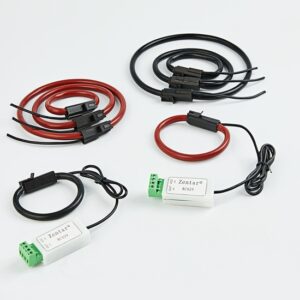The safe operation and management of transformers is the key to everyone’s daily work. Based on the experience exchanges on the analysis of abnormal operation conditions and common problems of transformers, it will be helpful to immediately and accurately distinguish the causes and characteristics of common faults, and take immediate measures to ensure The safe operation of machinery and equipment. The variable frequency series resonance test equipment uses a multi-level superposition method. Several series reactors can be used in series and parallel applications. The voltage divider can be used to accurately measure the experimental working voltage, and can also be used as a compensation capacitor for small-capacity samples to promote series resonance It can be carried out in the range of 30-300Hz.
Transformer
Transformers are essential electrical equipment in the power transmission and transformation system software. According to the operation and maintenance management regulations, transformers must be inspected on time, so that they can immediately grasp and grasp the operation status of the transformer, and immediately take measures and countermeasures to eliminate common faults in the budding period. , Thereby ensuring the safe operation of the transformer. Based on the experience of transformer operation, maintenance and management, we analyze and summarize the abnormal operation and common problems of transformer as follows:
- An abnormal situation found by the sound of the transformer
- When single-phase grounding occurs in the power grid or series resonance overvoltage is caused, the sound of the transformer is sharper than usual;
- When the electromechanical equipment with a large space is started, the load changes greatly, which makes the noise of the transformer amplify. For example, when the transformer contains loads such as electric arc furnaces, silicon controlled rectifiers, etc., because of the harmonic current content, there will be an intermittent sound of “yah” or “guckling” in the transformer for an instant;
- Overload makes the transformer emit a high and heavy “humming” sound;
- Some parts are loose. For example, the core screw of the transformer core is too loose or the parts are ignored on the transformer core. The transformer emits obvious and uneven “noise” or “beating” and “blowing”. ll;
- The internal contact of the transformer is poor, or the insulation layer has penetrated, and the transformer emits a “cracking” or “creaking” sound, and this sound changes with the distance between the common fault points;
- When the system software has a short-circuit fault or a grounding device, according to a very large short-circuit fault current, the transformer will emit a “crackling” noise, which will cause a great rumbling noise when it is more serious;
- When the system software generates series resonance of the magnet, the transformer will produce uneven noise.
- Under all normal loads and all normal cooling methods, the temperature of the transformer continues to rise
- Because the vortex or the destruction of the insulation layer of the core screw used to clamp the transformer core will cause the transformer’s oil temperature to be high. After the insulation layer of the core screw is destroyed, the insulation layer between the core screw and the ferrite core is destroyed. At this time, there is a very large current. According to the core screw, the screw will become hot and the oil temperature of the transformer will be high. .
- Short-circuit faults between layers or turns in the winding part, common faults in internal contacts, increased loop resistance, and short-circuit faults with large resistors on the secondary route, which will also cause high oil temperature.
- The situation where the tone of transformer insulating oil has changed significantly
Transformer oil is likely to come into contact with gas during operation, and slowly digest and absorb moisture in the air, thereby reducing the dielectric strength energy. In addition, transformer oil is also very likely to digest, absorb and melt a lot of gas, because the oil often operates at higher temperatures, and when the oil touches the oxygen in the air, it transforms into various metal oxides, and this metal oxide is partial. Acid is very easy to cause corrosion of the metal materials and insulating layer materials inside the transformer, and increase the dielectric loss of the oil. As the compressive strength of the insulating layer is reduced, it will cause short-circuit failures in the transformer, which is very easy to cause the winding and the casing to wear. through.
Fourth, the condition of the oil pump in the oil pillow or explosion-proof pipe
When the secondary system software suddenly has a short-circuit failure, and maintenance refuses to operate, or there is a common failure of internal short-circuit failure, and the air vent and explosion-proof tube are blocked, the internal high temperature and high temperature will cause the transformer oil to suddenly spray out, and the oil level will be raised after the spraying. Decrease, it may cause CBM maintenance actions.
Five, the occurrence of three-phase voltage imbalance
- The unbalanced three-phase load causes the neutral line to shift, which makes the three-phase voltage unbalanced;
- The system software generates magnet series resonance, which makes the three-phase voltage unbalanced;
- Inter-turn and solid layer short-circuit faults occur in the winding part, resulting in unbalanced three-phase voltage.
- The posture of the relay protection device
The posture of the relay protection device generally indicates that there are common faults inside the transformer. CBM maintenance is the key maintenance of the transformer. It can monitor part of the common faults generated inside the transformer. It is often the first light coalbed methane action to signal, and then the heavy coalbed methane action to remove the gate.
- There are several reasons for the action of light gas coalbed methane:
(1) Gas enters the transformer due to the imperfect oil-water separator, oil supply and refrigeration system;
(2) Temperature reduction and oil leakage slow down the oil volume;
(3) Common faults inside the transformer cause a small amount of gas;
(4) The internal short-circuit fault of the transformer;
(5) Common faults in the secondary circuit of protection equipment. Based on the equivalent schematic diagram of the current transformer, the basic principles and characteristics of the two current transformer transformation ratio inspection methods (current method and working voltage method) are discussed. A simple and reliable current transformer transformation ratio inspection is strongly recommended. On-site experiment method-working voltage method. From the perspective of application, in the analysis of the basic principles of current transformer wiring, the paper summarizes several types of wire connections of the current transformer in the differential protection of double-coil transformers; in addition, it introduces in detail the optical rotation of the current transformer is unknown. The wire connection method of the current transformer in the differential protection of the dual-coil transformer under the conditions.
Current transformers have a key function in electrical equipment, so some characteristics of current transformers are also relatively high in order to integrate the coordination of actions and high frequency on electrical equipment. Current transformer isolation switch tester and high current tester are technically professional power engineering experimental equipment test equipment. Xiamen ZTC Technology Co., Ltd has been focusing on the product development, manufacturing, and marketing of current transformers for many years.
- Based on the equivalent schematic diagram of the current transformer, discuss the basic principles and characteristics of the two current transformer ratio inspection methods (current method and working voltage method), and strongly recommend a simple and reliable current transformer ratio Check the field experiment method-working voltage method.
The on-site transformation ratio inspection experiment during the work handover of the current transformer and after the winding is removed has been included in the key experimental new items. Although the accuracy of the transformation ratio of the current transformer should be ensured by the manufacturing unit, for various reasons, it can occasionally be checked out incorrectly during field experiments (most of which are tapped errors). Therefore, the on-site transformation ratio inspection experiment of the current transformer has become a new project that will not change for many years.
The principle of the current transformer is about the same as that of the transformer. The difference is that the alternating main magnetic flux in the transformer core is caused by the alternating current on both sides of the primary electromagnetic coil, while the alternating main magnetic flux in the current transformer core is caused by the primary electromagnetic coil. Due to the internal current, the primary primary magnetic flux magnetically induces a secondary potential difference in the secondary electromagnetic coil, resulting in a secondary current.
From the principle of current transformers, it is known that the ratio of the primary turns to the secondary turns is what determines the transformation ratio of the current transformer. The key reasons that endanger the transformation ratio error of the current transformer are:
(1) The size of the transformer current, the ratio difference The sum angle difference expands with the decrease of the secondary current;
(2) the size of the secondary load, the ratio difference and the angle difference decrease with the decrease of the secondary load;
(3) the power factor of the secondary load of the current transformer, accompanied by the secondary load The expansion of the power factor, the reduction of the ratio difference and the expansion of the angle difference;
(4) the harm of the switching power supply frequency;
(5) Other factors. The main internal parameters of the current transformer are also likely to cause the transformation ratio error, such as the characteristic impedance of the secondary electromagnetic coil, the core cross section, the core material, the number of secondary turns, etc., but it is determined by the design plan and manufacturing decision.
The error experiment of the current transformer transformation should be carried out by the manufacturer during the original factory experiment or in the laboratory. The field test of the current transformer ratio is attributable to the inspection characteristics, that is, the key to check the coil turns ratio without considering the above-mentioned harm to the error of the current transformer ratio. According to the basic principle of electric welders, the coil turns ratio is equivalent to the number of working voltage ratio or current ratio. Therefore, both the accurate measurement of the working voltage ratio and the accurate measurement of the current ratio can measure the turns ratio of the coil.
- When no abnormal condition of the transformer is found in the external inspection, the characteristics of the gas in the Buchholz relay should be checked
(1) If the gas accumulated in the Buchholz relay is not flammable and has no color and taste, and the mixed gas is mainly inert gas, the content of co2 exceeds 16%, and the open flash point of the oil does not decrease, it indicates that it is gas entering In the Buchholz relay, at this time, the transformer can operate again.
(2) If the gas is flammable, it indicates that there are common faults inside the transformer. The characteristics of the common faults inside the transformer should be evaluated based on the characteristics of the gas accumulated in the Buchholz relay. For example, the hue of the gas is:
a, yellow non-flammable, and the carbon monoxide content exceeds 1-2%, it is the destruction of the wooden insulating layer;
b. Gray and black are flammable, and the hydrogen content is below 30%, there is a nicotine smell, and the flash point of the opening is reduced, which indicates that the oil has dissolved due to over-temperature or that there has been a short circuit in the oil. Common faults;
c. Light gray with obvious peculiar smell and flammable is damaged by the insulation layer of paper or cardboard.
(3) If the above analysis cannot properly distinguish the common faults of self-limiting diseases in the transformer, gas chromatography analysis can be used to make a proper resolution.
When conducting meteorological chromatograph analysis, the common faults in the transformer can be distinguished from the content of hydrogen, nitrogen compounds, carbon monoxide, carbon dioxide, and acetylene gas. Under normal conditions:
a. When the content of hydrogen and nitrogen compounds increase greatly, and the content of carbon monoxide and carbon dioxide does not change much, it is a common fault of over-temperature of bare metal (such as: tapping power switch);
b. When the content of carbon monoxide and carbon dioxide is greatly increased, it is a common fault of over-temperature of solid insulators (wood, paper, cardboard);
c. When the hydrogen and nitrogen compound gases are elevated, the acetylene gas content is very high, which is a common fault of charging and discharging such as short-circuit faults between turns or more grounding devices of the transformer core.
Seven, the situation of short-circuit failure and explosion of the insulating porcelain waterproof casing
- Because the quality of the sealing rubber sheet is not good, the installation part is unreasonable, the screw cap is too loose, etc., the waterproof casing is not tightly sealed, and the insulating layer is destroyed due to water seepage or moisture infiltration;
- There is free discharge in the delamination gap of the insulating layer of the capacitive sensor waterproof casing
- The scale on the surface of the waterproof casing is serious, and there are large debris and cracks on the waterproof casing, which will cause short-circuit failure and explosion of the waterproof casing.
Eight, the condition of the tap changer failure
There are “creaking” charging and discharging sounds on the transformer tank, and the ammeter shakes with the sound. CBM maintenance is likely to signal, and the opening flash point of the oil is reduced. This kind of situation may be caused by the failure of the tap changer.
- The reasons for the failure of the tap changer are as follows:
(1) The working pressure of the tap changer contact is not enough, the working pressure of the contact roller is uneven, which reduces the reasonable total contact area, and it is seriously damaged due to the insufficient impact toughness of the gold-plated layer. The tap switch will be caused. damage;
(2) Poor contact of the tap changer can not withstand the impact of the short-circuit capacity and cause failure;
(3) When the tap switch is reversed, the switch is burnt out because of the incorrect conversion of the tap location;
(4) The two-color spacing is insufficient, or the material characteristics of the insulating layer are reduced, and the short-circuit failure occurs under the overvoltage effect.
If you notice changes in the amount of current, working voltage, temperature, oil volume, and oil color, you should immediately take an oil sample for analysis by a meteorological chromatograph. When it is judged as a switch failure, the tap switch should be immediately transferred to the intact gear operation.
- During operation, part of the contacts touched by the switch is likely to be damaged. Long-term immersion of unused contacts in oil is likely to cause a layer of air oxidation film due to air oxidation, resulting in poor tap contact. Therefore, in order to avoid tap changer failure, the resistance measurement of each tap must be accurately measured during conversion. If the three-phase resistor is found to be unbalanced, the distance between the three-phase resistors should not exceed 2%.
- When inverting the tap, check the specific connection between the tap switch indicator outside the fuel tank and the internal connector to ensure proper wiring. In addition, each time the tap is turned, the tap switch rocker should be rotated more than 10 times to remove the air oxide film and oil that touched a part of it, and then adjust it to a new position.
Nine, analysis of the cause of transformer failure
According to the fault of the transformer, it can be generally divided into power circuit fault and magnetic circuit fault. The key to power circuit failure refers to wire loop and lead failure, etc. Commonly include: the insulation layer of the electromagnetic coil is embrittled, re-moisture, poor contact of the switcher, poor quality of raw materials and manufacturing processes, overvoltage shock resistance and secondary systems Faults caused by software short-circuit faults, etc. Equivalent circuit faults generally refer to the faults between the transformer core, yoke and clamps. The common ones are: ferrite core short-circuit faults, core screws, and damage to the insulation layer between the yoke clamps and the transformer core. Charging and discharging caused by poor grounding of the transformer core.
The above is only the basic and comprehensive analysis and analysis of the transformer sound, temperature, oil volume, appearance and other conditions of the fault, because the transformer fault is not a manifestation of a single element, but only involves many elements, sometimes Even an illusion will occur. Therefore, it is necessary to carry out the characteristic experiment and comprehensive analysis of the transformer when necessary, so that the cause of the fault can be found accurately and reliably, the fault characteristics can be determined, and a sound solution can be clearly proposed to ensure the safe operation of the transformer.




